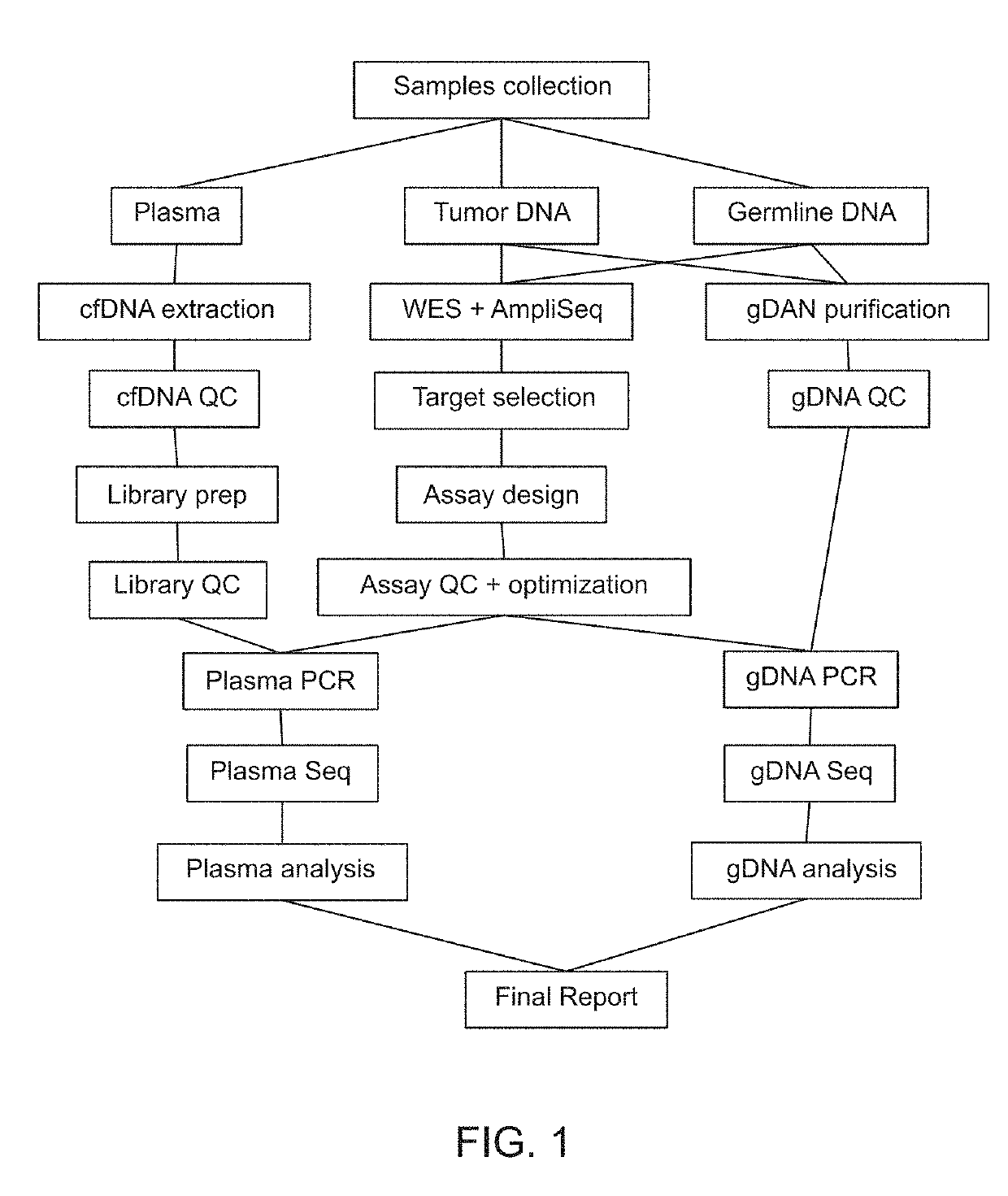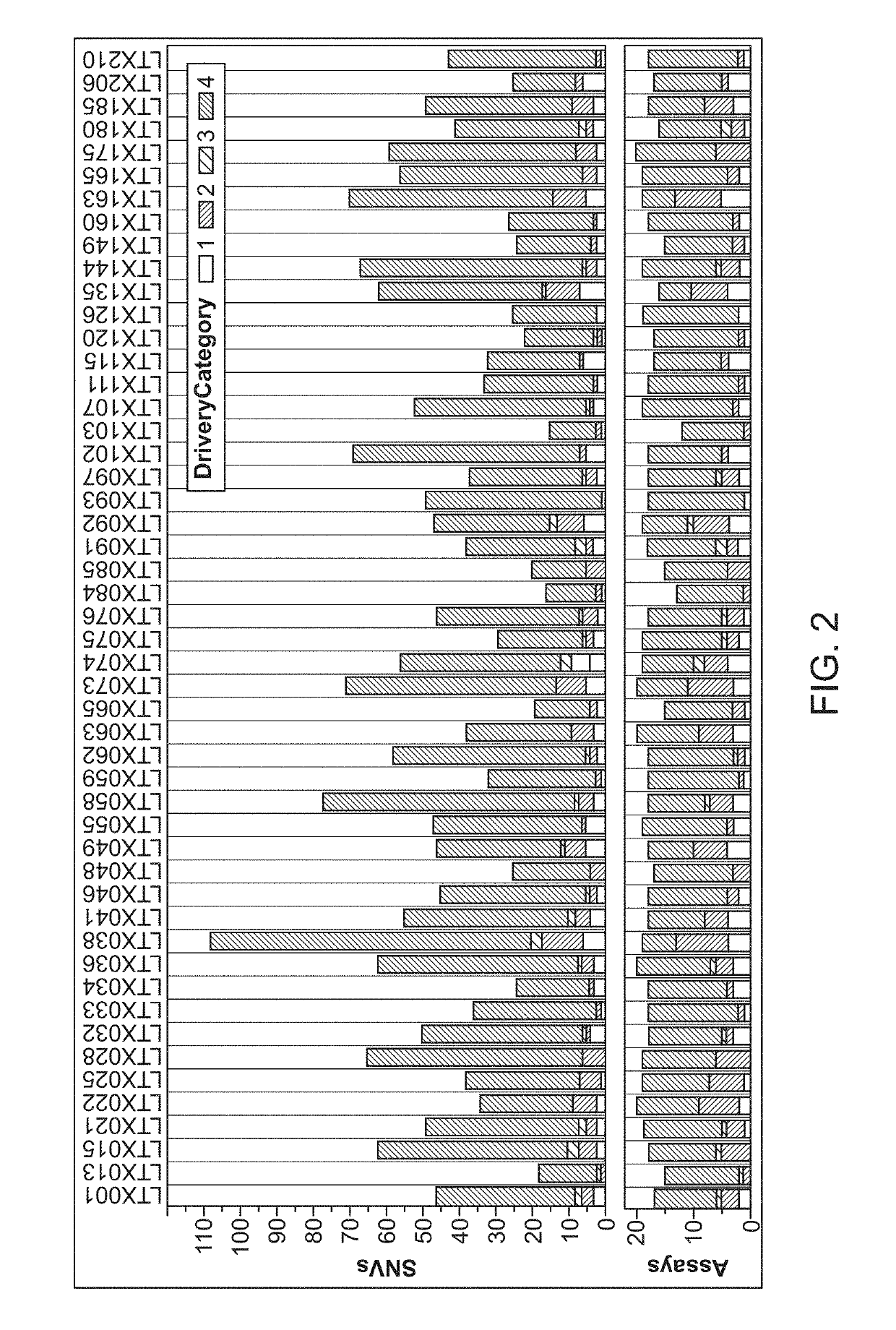Methods for cancer detection and monitoring
a cancer and monitoring technology, applied in the field of methods for cancer detection and monitoring, can solve the problems of insufficient imaging-based detection to detect relapse or metastasis, invasive biopsy of tumor tissue, and high risk of surgical complications
- Summary
- Abstract
- Description
- Claims
- Application Information
AI Technical Summary
Benefits of technology
Problems solved by technology
Method used
Image
Examples
example 1
zed Circulating Tumor DNA Analysis to Monitor Colorectal Cancer
[0791]Early detection of disease recurrence has been shown to improve survival in patients with colorectal cancer (CRC). Detection of circulating tumor DNA (ctDNA) post-operatively defines a subset of CRC patients with very high risk of recurrence. Previous studies have performed ctDNA analysis to monitor tumor burden in early-stage CRC using small gene panel sequencing or digital droplet PCR.
[0792]The aim of this example was to use a personalized multiplex-PCR NGS platform targeting 16 tumor-specific mutations per patient to assess minimal residual disease postoperatively and to monitor treatment response in CRC.
[0793]130 patients with stage I-IV CRC, treated with curative surgery, and (optional) adjuvant chemotherapy were included (See Table 1). Plasma samples were collected longitudinally at baseline prior to surgery and at scheduled control visits after surgery (FIG. 20A).Whole-exome sequencing identified somatic mut...
example 2
g of Plasma cfDNA from Patients with Locally Advanced Bladder Cancer for Surveillance and Therapeutic Efficacy Monitoring
[0800]Studies on different cancer types have shown that circulating tumor DNA (ctDNA) levels can be efficiently used to monitor treatment response to neoadjuvant therapy and / or detect disease recurrence earlier than clinical and radiological detection. In bladder cancer, mutations in plasma have been previously used to monitor response during treatment and identify early signs of metastatic disease. Recently, longitudinal ctDNA detection in patients with NSCLC was described and a personalized circulating tumor DNA (ctDNA) detection assay was developed (Signatera™ RUO).
[0801]The aim of the study was to use patient-specific mutations identified in the primary tumor to detect metastatic relapse, evaluate prognosis, and monitor treatment response in ctDNA from longitudinally-collected plasma samples.
[0802]Clinical Protocol. Patients diagnosed with locally advanced mus...
example 3
nsitive Patient-Specific Multiplex PCR NGS-Based Non-Invasive Cancer Recurrence Detection and Therapy Monitoring Assay
[0810]The identification of tumor mutations in circulating cell-free DNA holds great potential for the non-invasive detection of cancer relapse before clinical manifestation, detection of minimal residual disease after curative-intent treatment, and detection of therapeutically relevant mutations. To review and report analytical validation results for the detection of tumor-specific variants by the current version of the assay.
[0811]Signatera RUO. The Signatera™ (RUO) process starts with identifying and prioritizing somatic mutations from whole-exome sequencing of tumor and matched normal samples. Patient-specific multiplex-PCR assays targeting 16 somatic single-nucleotide and indel variants are then assayed by massively parallel sequencing in plasma samples collected throughout the patient's disease course to help detect and monitor circulating tumor DNA.
[0812]Analy...
PUM
| Property | Measurement | Unit |
|---|---|---|
| Fraction | aaaaa | aaaaa |
| Fraction | aaaaa | aaaaa |
| Fraction | aaaaa | aaaaa |
Abstract
Description
Claims
Application Information
 Login to View More
Login to View More - R&D
- Intellectual Property
- Life Sciences
- Materials
- Tech Scout
- Unparalleled Data Quality
- Higher Quality Content
- 60% Fewer Hallucinations
Browse by: Latest US Patents, China's latest patents, Technical Efficacy Thesaurus, Application Domain, Technology Topic, Popular Technical Reports.
© 2025 PatSnap. All rights reserved.Legal|Privacy policy|Modern Slavery Act Transparency Statement|Sitemap|About US| Contact US: help@patsnap.com



